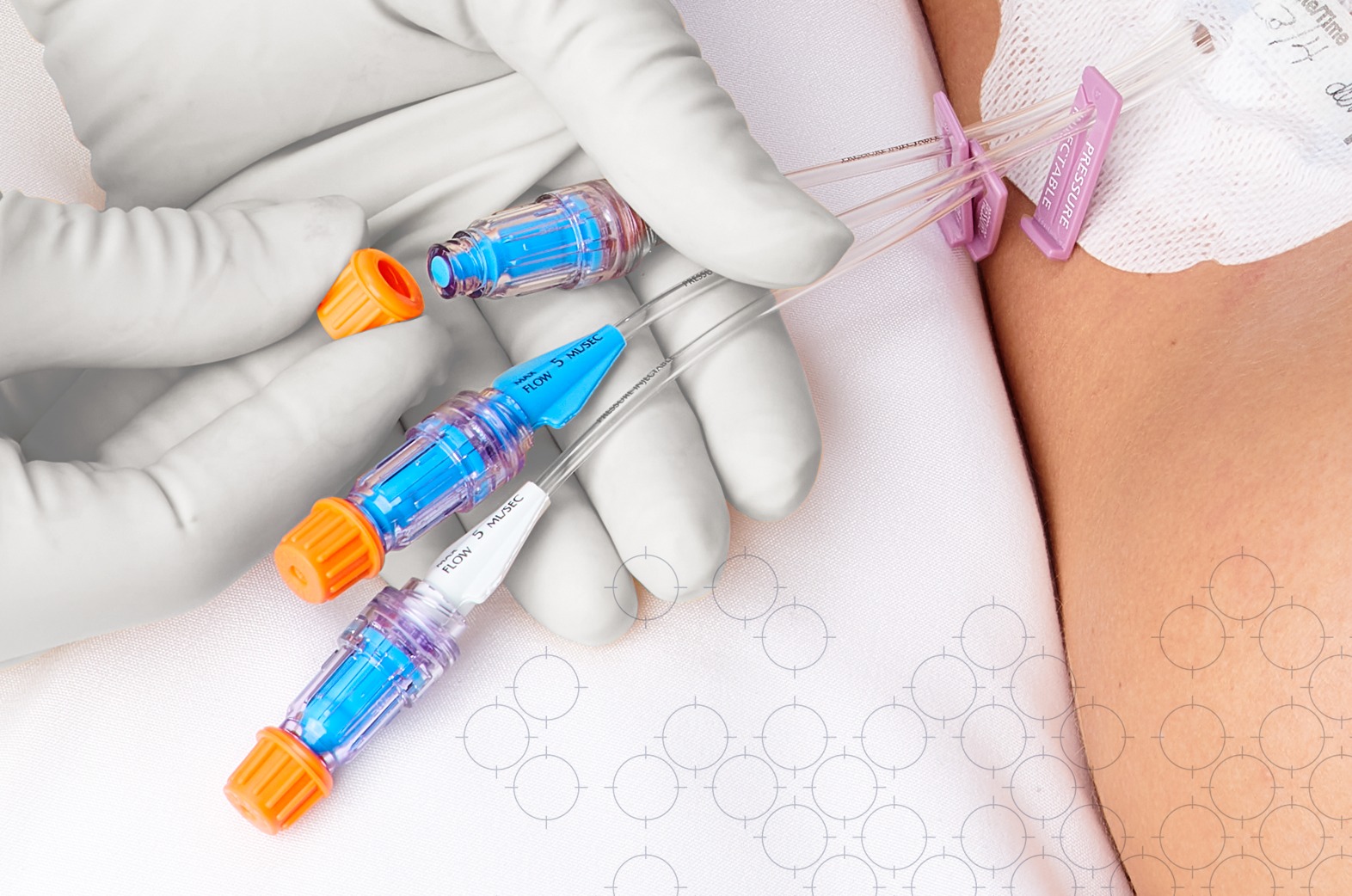Vascular access device and catheter hub care: Best practices
Reduce CABSI risk by following five key guidelines for disinfection.

Clinicians work hard to keep patients safe and prevent infection every day. But it’s not an easy process. Staying current on the latest infusion recommendations is challenging. And busy shifts, multiple patients to manage and different levels of experience add to the difficulty.
The good news? You can reduce catheter-associated bloodstream infections (CABSIs) with the right approaches. The 2021 Infusion Nurses Society (INS) Infusion Therapy Standards of Practice released in January presents effective, evidence-based standards around the care and maintenance of needleless connectors.1
Jill Nolte, BS, BSN, Medline Clinical Resource Manager, says, “We’ve all worked really hard to reduce infection at the point of insertion using bundles. Now we have to focus on care and maintenance—preventing intraluminal contamination.”
She explains the problems that needleless connectors have both solved—and inadvertently created.
“Needleless connectors have essentially eliminated needlestick injuries and accidental disconnects,” says Nolte. “But they brought along something no one anticipated—increased risk of intraluminal infection. Hub manipulation is a common cause of CABSI in long-term catheters.2 So when we’re not disinfecting connector hubs consistently and correctly, we’re literally infusing bacteria into our patients. Disinfection caps solve that problem.”
When we’re not disinfecting connector hubs consistently and correctly, we’re literally infusing bacteria into our patients. Disinfection caps solve that problem.

Jill Nolte, BS, BSN
Medline Clinical Resource Manager
Key INS guidelines help reduce intraluminal infection and CABSI
Cap use and disinfection techniques are among the evidence-based best practices the INS recommends. Here are five highlights:
1. Disinfect and cap all lines
In 2016, the INS advised clinicians to protect central lines with disinfectant caps. 2021 standards go further saying all catheter lines, not just central lines, should be capped.
Clinicians know that central lines are accessed frequently across units—several times a day for blood draws, maintenance flushes, medication and fluid delivery, dialysis and other treatments. That increases infection risk. But IV lines can be contaminated from exposure to hands not properly cleaned; incorrect catheter insertion; and inadequate disinfection of catheter hubs, ports or needleless connectors before accessing the line.3
“Until now, we’ve placed a lot of focus on central lines, but it’s all one bloodstream,” says Nolte, who has seen firsthand how complex vascular access management can be at hospitals. “This standard recognizes that if not properly maintained and disinfected, all IV access points are an open door for contaminants. Any type of vascular access catheter can cause a CABSI.”
2. Follow best practices for active or passive disinfection
Many clinicians practice an active “scrub the hub” disinfection technique using 70% alcohol pads and that can work. But the INS cites evidence that “active disinfection” with 70% alcohol-based chlorhexidine gluconate (CHG) swab pads or “passive disinfection” using disinfection caps is much more effective in reducing CABSI than alcohol pads alone.
“Active techniques like scrubbing have more room for human error,” explains Nolte. “Disinfecting the threads and surfaces of needleless connectors properly and consistently with alcohol wipes can be tricky. The amount of friction used and for how long differs from person to person, and different disinfectants and dry times have different results in microbial kill. Good practices fall off when clinicians are rushed or distracted. In addition, missteps like reusing wipes and setting connectors down on surfaces introduce bacteria. Finally, scrubbing practice is hard to monitor.”
In other words, human factors in active disinfection—variability in technique, training and consistency—can lead to ineffective practice that allows bacteria to enter the intraluminal surface of the catheter. And that increases CABSI risk.4
Needleless connectors brought along something no one anticipated: increased intraluminal infection risk. Disinfection caps solve this.

Jill Nolte, BS, BSN
Medline Clinical Resource Manager
3. Use disinfection caps on every line, every time
So how can you account for human factors? Passive disinfection using disinfection caps eliminates much of the guesswork and variability of active techniques.4 With one twist of a cap, the hub is disinfected in 30 seconds. 70% isopropyl alcohol bathes the surface, kills bacteria and then provides a physical barrier for up to seven days.
“Caps make it much easier to standardize practice,” says Nolte. “Clinicians simply discard the old cap every time it’s removed and replace it with a new one. As for monitoring, unlike rounding with clinicians to observe their practice, visual confirmation is easy. Caps are either on all lines or not.”
The INS and similar healthcare quality groups around the world including CVAA, ECRI, NHSE, ONS, SHEA and others recognize the effectiveness of caps in reducing CABSI and recommend their placement on all catheter lines.
4. Make best practices easy
The high cost of CABSIs to patients and healthcare organizations makes standardizing practice essential. The INS recommends having all supplies at the bedside to improve compliance. Using a saline flush syringe with an integrated disinfection cap supports best practice and helps ensure that clinicians use caps on every line, every time.
Nolte says, “Integrating the disinfection cap onto a flush syringe ensures the cap is right there when needed. No one has to run back to a supply room or be tempted to reuse an old cap because they’re rushed. If it’s right there on your syringe, you’re going to use it, you can’t forget it and you’re ready to go.”
5. Support compliance with consistent training, reminders and rewards
Both INS and ECRI outline the importance of educating and engaging staff and patients and gaining leadership support around recommended techniques.
To keep best practices top of mind:
- Give “on the spot” rewards to nurses with caps on every port or to units that consistently protect lines properly. Coupons from the gift shop or cafeteria or a piece of wrapped candy are simple and fun.
- Use posters to highlight best practices
- Use bulletin boards to show trends and CABSI reduction successes
Says Nolte, “Have fun with it. Making cap use easy and consistent can help significantly reduce CABSI. It’s worth it.”
Key takeaway
2021 INS Guidelines offer updated best practices around the maintenance and care of needleless connectors on vascular access catheters. Guidelines support active or passive disinfection of every line, even peripheral IVs to prevent intraluminal infection. Evidence shows that disinfecting hubs with alcohol/CHG swabs or using disinfection caps may achieve better CABSI reduction than using alcohol wipes alone. Disinfection caps overcome inconsistent active disinfection or “scrub the hub” techniques and provide an infection barrier. And saline syringes with integrated caps make best practice second nature by providing everything clinicians need when accessing and flushing lines. Clear policies and consistent staff training in every unit are essential and help keep best practices top of mind.
Looking for more ways to help clinicians keep patients safe from CABSIs?
Watch webinar “Every Port Needs a Cap”
Learn more from Medline Clinical Resource Manager Jill Nolte, BS, BSN, about INS recommended disinfection practices, cap use and strategies to improve compliance.
Request a Discovery Assessment
We can help you standardize best practices to reduce CABSI rates. Assessments analyze practices and policies, identify gaps in care, review products and provide a customized action plan.
Request a SwabFlush Product Demo
Explore our full Vascular Access Health Solution
From best practice guidance and education to the right system of products, we help you create a culture of safety.
References:
1. Gorski, L. A., Hadaway, L., Hagle, M. E., Broadhurst, D., Clare, S., Kleidon, T., Meyer, B. M., Nickel, B., Rowley, S., Sharpe, E., & Alexander, M. (2021). Infusion Therapy Standards of Practice, 8th Edition. Journal of Infusion Nursing, 44(1S), S1–S224. https://doi.org/10.1097/nan.0000000000000396
2. Mermel, L. A. (2010). What Is the Predominant Source of Intravascular Catheter Infections? Clinical Infectious Diseases, 52(2), 211–212. https://doi.org/10.1093/cid/ciq108
3. Carolinas Healthcare System. (Revised 2015, June 24.) Preventing IV Catheter Associated Infections: Annual Compliance Education. https://atriumhealth.org/documents/acemodules/blueridge/prevent-iv-cath-infections.pdf
4. Moureau, N. (2015). Disinfection of Needleless Connector Hubs: Clinical Evidence Systematic Review. Journal of the Association for Vascular Access, 20(4), 266. https://doi.org/10.1016/j.java.2015.10.089
